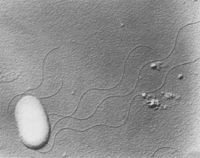Gluconacetobacter diazotrophicus: Difference between revisions
| Line 17: | Line 17: | ||
[[File:G_Diazotrophicus_photo_1.png|200px|thumb|left|Figure 1 : Electron micrograph of a G. diazotrophicus cell. Peritrichous flagella are visible. The dimensions of the cell are 0.7-0.9 μm x 2 μm. Photo taken by M. Gillis, K. Kersters, B. Hoste et al. (1989)]] | [[File:G_Diazotrophicus_photo_1.png|200px|thumb|left|Figure 1 : Electron micrograph of a G. diazotrophicus cell. Peritrichous flagella are visible. The dimensions of the cell are 0.7-0.9 μm x 2 μm. Photo taken by M. Gillis, K. Kersters, B. Hoste et al. (1989)]] | ||
Gluconacetobacter diazotrophicus is a symbiotic, plant-growth promoting bacteria. It was isolated from the roots and stems of Brazilian sugarcane plants in 1989 (a). Upon discovery, the bacterium was named Saccharobacter nitrocaptans. Due to its acetic acid production and similarity to previously classified bacteria, however, it was later renamed to Aacetobacter diazotrophicus. Completion of 16S ribosomal RNA analysis led to a reclassification to its current designation and taxonomy (a,b,c). | |||
G. diazotrophicus is a Gram-negative, nonspore forming and nitrogen fixing obligate aerobe. The bacterium’s cells are shaped like straight rods with rounded ends and motility is provided by 1-3 lateral or peritrichous flagella. Cellular dimensions are approximately 0.7-0.9 μm x 2 μm (b). When viewed under a microscope, cells are single, paired, or chainlike in structure. The temperature and pH growth optimums are 30°C and 5.5 respectively. The bacterium is acid-tolerant and can also both grow and fix nitrogen at pH of 3.0 and below (a,b). Additionally, G. diazotrophicus grows optimally at a sucrose concentration of 10%, as found in its natural host, but is capable of growth at up to 30% sucrose under laboratory conditions. The bacteria has been shown to grow abundantly on other carbon substrates like D-galactose, D-fructose, and D-mannose (a). | |||
Unlike many other bacteria that engage in symbiosis with plants, G. diazotrophicus is an endophyte and does not stimulate the production of nodules (a). Without a host plant, the bacteria will not survive in the soil for more than two days (e). Most host plants of G. diazotrophicus contain relatively high levels of sucrose, similar to the sugarcane on which it was discovered (d). | |||
==Genome Structure== | ==Genome Structure== | ||
Revision as of 19:29, 25 April 2022
Classification
Bacteria; Proteobacteria; Alphaproteobacteria; Rhodospirillales; Acetobacteraceae; Gluconacetobacter
Species
|
NCBI: [1] |
Gluconacetobacter diazotrophicus
Description and Significance
Describe the appearance, habitat, etc. of the organism, and why you think it is important.
Gluconacetobacter diazotrophicus is a symbiotic, plant-growth promoting bacteria. It was isolated from the roots and stems of Brazilian sugarcane plants in 1989 (a). Upon discovery, the bacterium was named Saccharobacter nitrocaptans. Due to its acetic acid production and similarity to previously classified bacteria, however, it was later renamed to Aacetobacter diazotrophicus. Completion of 16S ribosomal RNA analysis led to a reclassification to its current designation and taxonomy (a,b,c).
G. diazotrophicus is a Gram-negative, nonspore forming and nitrogen fixing obligate aerobe. The bacterium’s cells are shaped like straight rods with rounded ends and motility is provided by 1-3 lateral or peritrichous flagella. Cellular dimensions are approximately 0.7-0.9 μm x 2 μm (b). When viewed under a microscope, cells are single, paired, or chainlike in structure. The temperature and pH growth optimums are 30°C and 5.5 respectively. The bacterium is acid-tolerant and can also both grow and fix nitrogen at pH of 3.0 and below (a,b). Additionally, G. diazotrophicus grows optimally at a sucrose concentration of 10%, as found in its natural host, but is capable of growth at up to 30% sucrose under laboratory conditions. The bacteria has been shown to grow abundantly on other carbon substrates like D-galactose, D-fructose, and D-mannose (a).
Unlike many other bacteria that engage in symbiosis with plants, G. diazotrophicus is an endophyte and does not stimulate the production of nodules (a). Without a host plant, the bacteria will not survive in the soil for more than two days (e). Most host plants of G. diazotrophicus contain relatively high levels of sucrose, similar to the sugarcane on which it was discovered (d).
Genome Structure
Describe the size and content of the genome. How many chromosomes? Circular or linear? Other interesting features? What is known about its sequence?
Cell Structure, Metabolism and Life Cycle
Interesting features of cell structure; how it gains energy; what important molecules it produces.
Ecology and Pathogenesis
Habitat; symbiosis; biogeochemical significance; contributions to environment.
If relevant, how does this organism cause disease? Human, animal, plant hosts? Virulence factors, as well as patient symptoms.
References
Author
Page authored by Isaac Coker, Kyra Colston, and Danielle DeCesaris, students of Prof. Jay Lennon at Indiana University.

